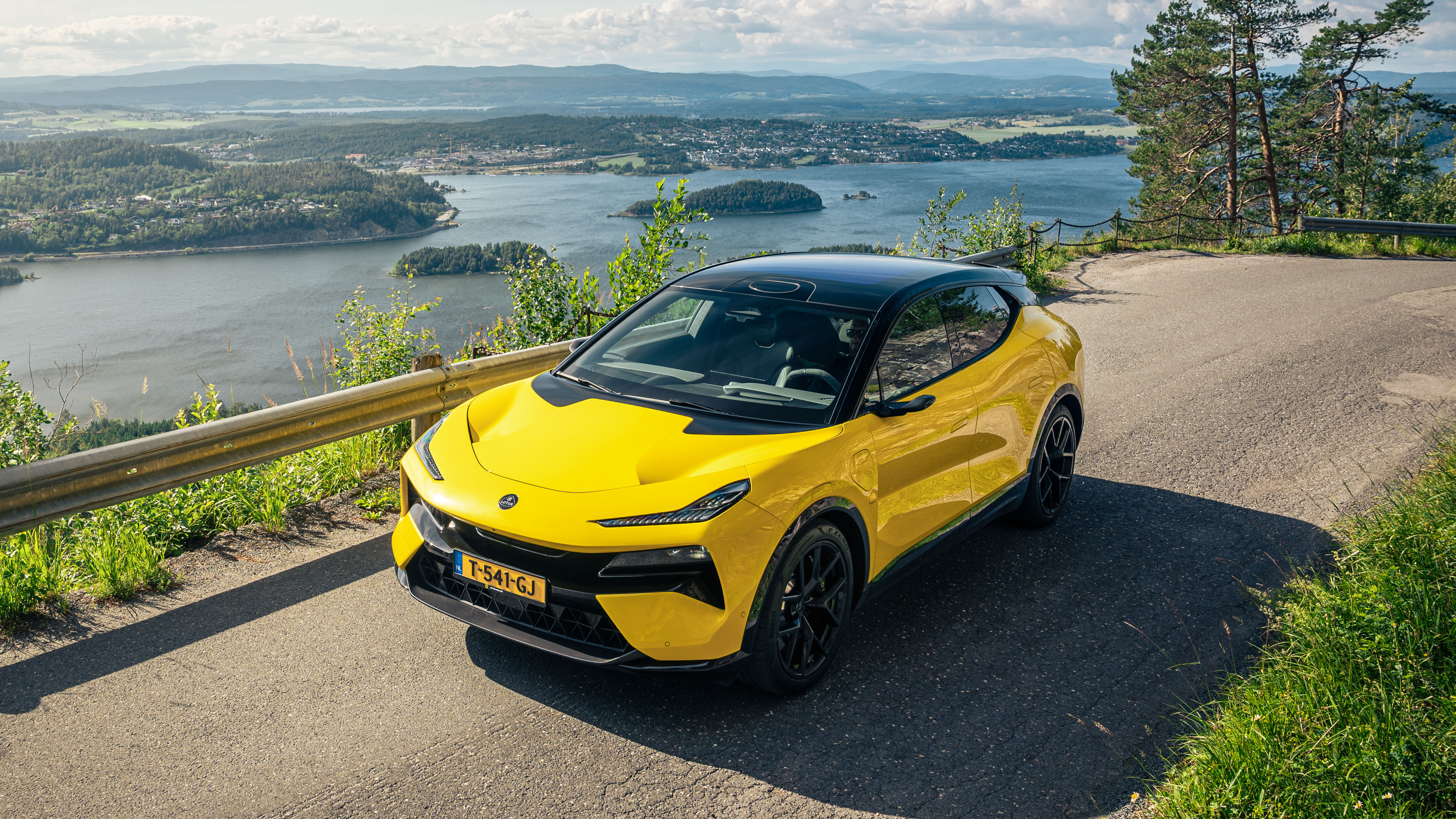
Complicate then add weight: is the new Eletre SUV a *real* Lotus?
Love it or loathe it, Lotus’s new electric SUV will help keep the firm’s balance books in the green. But is it a Lotus in anything but name?
It's raining in Norway. Not a gentle patter, either, more a deluge wrapped in a downpour, the sweet smell of petrichor swamped by the sheer volume of water hosing out of the sky. The forest holds a gloomy edge, sweating myth and looking like a thousand dark bedtime stories, suspicious, soggy huddles of spruce and alder plotting with the Norwegian pines. And yet the roads are good. Incredible, even. Two lanes of scarred tarmac that shift and loop through the landscape following the contours of the lakes, rising and falling like a breath. Apart from the disconcerting drag of the pools of standing water, driving doesn’t get much better than this – a Lotus doing what it was born to do – attack an interesting, twisty road with vim, engaging and fun.
Except that this isn’t your usual Lotus. It’s 2.5 tonnes of electric SUV wearing a Lotus badge, potentially a sheep in wolf’s clothing, big and yellow enough to look like someone chipped off a shard of sun and plonked it down on a road somewhere outside Oslo. Recalibration is needed. This is the Lotus Eletre. It is not what we’re used to.
Of course, according to the court of public opinion, the Lotus Eletre should not exist. Mainly because it’s not a sports car. Worse than that, it’s an SUV, is electric and tech heavy, and produced in Wuhan, China instead of in the UK in Hethel, Norfolk. It is therefore, according to some sections of the intellectual bin fire that is social media, the antichrist with 22-inch wheels.
Photography: Jonny Fleetwood
But ignore all that for a second. Because the Eletre may be a big, fat electric SUV that has as much to do with traditional Lotus values as a canoe has to a cruise ship, but it still somehow has Lotus in there somewhere. Maybe it's the steering - direct, chatty, quick. Maybe it's the dual chamber air suspension that soaks away bumps without removing all feeling, or the torque vectoring and rear-wheel steering that manage a neat trick of appearing natural while rapidly managing grip and turn. It's the proverbial swan - calm on top, furious electronic paddling underneath. You may not want to like it, but you can't argue with the results: the Eletre is the most Lotus-like you can imagine an electric SUV could be. Although that does feel like a pretty egregious oxymoron.
Saying that, it'll still make you pause. Because the Eletre is so far from Lotus' usual orbit, it might as well be in another galaxy. A four- or five-seat electric SUV with two motors, all-wheel drive, a 112kWh battery and a kerbweight in its lightest iteration of 2,490kg. Yes, two and a bit times the weight of something like an Elise, a solid tonne heavier than an Emira. But if you're going to take steps to ensure Lotus' survival going forward, you need to take big steps - and in the current climate, that means an electric SUV.
Which means that we have a 'bespoke' Lotus platform spun from the generous bank account of Chinese parent company Zhejiang Geely Holding Group, sprinkled with defined effort to apply Lotusology to a car that was never going to be a hit with the hardcore fans. At launch, there are three models - Eletre, Eletre S and Eletre R - all virtually visually identical, all featuring the same 112kWh, 650kg battery pack, 800V charging gear and air suspension. The Eletre and Eletre S are mechanically the same and produce just over 600bhp with a 0-62mph time of 4.5 seconds, the R just over 900bhp and a sprint time of 2.95 seconds. You'll see an entirely respectable 373 miles of WLTP range from the lower powered cars, just over 300 for the R.
Is it pretty? Well, no. Because large SUVs struggle to look delicate, and even framed by the bulky natural wonder of the Norwegian forest, it still looks chunky. What it is, is striking with its "carved by air" design, with much more detail than first appears. There are more gaps for the aero, channels and voids that allow for new perspectives and streams of ejected spray, some interesting twin spoilers, lots of little turrets and nooks for the ADAS systems, a stuttering set of Rubik's Cube petals in the front grille that shutter the front of the car for aero or cooling. Less bolshy than a Lamborghini Urus, less bulky than a Tesla Model X.
Interestingly, even the max attack R version is a bit of a sleeper. It's not got extra wings, or identifiers bar gloss black wheels and its potentially sudden and surprising absence. But the R is all about what you can’t see. It has the same battery and 302bhp front motor as the other cars, but gets a bigger unit (where the others get a duplicated set front-to-rear) and two-speed box for the rear axle to provide just over 900bhp and 727lb ft of torque. The two ratios for the rear axle provide both lung compressing standing starts and some measure of efficiency when cruising. Of perhaps more practical use is a 50mph to 75mph time under two seconds. Blink, and it’s probably gone.
It does, however, also get the Lotus Dynamic Handling Pack (comprising Intelligent Active Roll Control and Active Rear Steering) as standard, Carbon Pack (lightly pointless in a car of this size), bespoke Pirelli P Zero tyres and an extra Track mode in the menus that plays with the battery conditioning settings and permanently opens the petals of the front grille, as well as messes with the traction control aggression. So there’s plenty going on under the skin, even if those extra muscles don’t bulge from the bodywork.
The inside of every Eletre is just as surprising, mainly because this isn’t some pared back Bauhaus Lotus interpretation of the usual luxury SUV tropes. In fact, in pictures it can look quite chintzy. But once you’re inside, it’s lovely. Materials are recycled and interesting, fit and finish as solid as you might hope. And it all works in terms of ergonomics – up front is a 12.6-inch driver info strip behind the hexagonal steering wheel plus a big head-up display, a 15.1-inch OLED touchscreen in the middle, with a couple of small rockers for aircon underneath. Paddles behind the wheel deal with brake regen (left) and driving modes (right). There’s wireless charging and enough storage, as well as a KEF stereo that’s almost worth the price of admission alone. There’s a digital personal assistant (voice control) and OTA updates. It’s got everything you might reasonably expect.
And a few things you don’t. There are 34 different sensors on the Eletre that allow for generous mapping of its environment. Four deployable lidar (two in pop-up turrets either end of the roof and two on the front wings), six radar, seven cameras and 12 ultrasonics. It’s enough to permit Level 4 autonomy if such things ever get past the lawyers. Thing is, among all this newness, this step change in what Lotus is supposed to be, there’s a whole lot to like. Mainly because when you do get to a good road, you’ll be able to tune out all the shiny things and genuinely have a good time driving it.
Obviously if you drive it to the maximum down a twisty road you will traumatise children and find your dog upside down with its head in the boot-mounted bass speaker. A literal subwoofer. The 600+bhp S is perfectly capable of going very fast indeed, rowing along at the kind of pace that would worry a proper sports car, although cycling through the various drive modes, it feels quite front-wheel-drive biased in Tour and could do with some more aggressive rear-wheel-drive cues in Sport. The 900bhp R version with the more powerful rear motor might be the answer to that question. The real surprise is that all Eletre are fun, and not with too many caveats, either. It’s just a good laugh in context. Certainly more than most of the competition, needing less managing than anything short of a petrol powered Porsche Cayenne. For a car as big and heavy as this, that’s almost genius.
Top Gear
Newsletter
Thank you for subscribing to our newsletter. Look out for your regular round-up of news, reviews and offers in your inbox.
Get all the latest news, reviews and exclusives, direct to your inbox.
Of course, it’s not perfect. The ADAS is annoying and a chore to continually switch off. The brakes can be disconcertingly grabby on initial contact – probably something to do with the regen blending – and yes, there’s room for that more aggressive handling balance in the more sporty modes. But as a first crack at what an electric Lotus SUV can be, it’s a bloody good effort.
So here we are, then. An electric Lotus SUV that we don’t want to like, but do. Feel free to be outraged, but if Lotus was selling enough two-seat sports cars with driving dynamics sharp enough to slice your fingertips off and the luggage capacity of a teaspoon, it wouldn’t need a car like this. You might have antipathy towards the platform, but you have to have empathy for the need of it. And it’s just the start: spun from the same electric bits will be a saloon, a smaller SUV and yes, a two-seat sports car. In fact, some would have you believe that in creating a vehicle like the Eletre, Lotus has somehow sold out. But that’s wrong. Lotus hasn’t sold out, it’s bought itself time and opportunity. And the Eletre will be the tip of the indignant social media iceberg when Lotus hasn’t just branched out, it’s trying to grow a whole new forest.
Trending this week
- Car Review
BMW 1 Series











